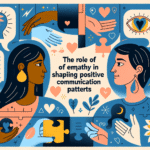
Stay Calm and Communicate: Navigating Relationship Conflicts with Ease – The Ultimate Guide
Introduction
In every relationship, conflicts are inevitable. Whether it’s a disagreement over household responsibilities, differing values, or even a misunderstanding, how we handle these conflicts can significantly affect the dynamics of our relationships. The phrase “Stay Calm and Communicate: Navigating Relationship Conflicts with Ease” encapsulates a powerful approach to resolving disputes and fostering understanding. In this ultimate guide, we’ll explore the nuances of conflict resolution, offering proven strategies to maintain calmness and encourage open communication.
Imagine a world where conflicts don’t tear us apart but instead bring us closer together. Picture yourself navigating disagreements with ease and confidence, transforming potentially explosive situations into opportunities for connection. This article will provide you with the tools and insights needed to make that vision a reality.
Understanding Conflict in Relationships
What Causes Conflict?
To effectively address conflict, we first need to understand its root causes. The following table outlines common sources of conflict in relationships:
| Source of Conflict | Description |
|---|---|
| Differences in Values | Varying beliefs and morals can lead to disagreements. |
| Poor Communication | Misunderstandings arise when messages are unclear. |
| External Stressors | Work, family pressures, and money troubles can heighten tensions. |
| Unmet Expectations | People often assume their partner knows what they want or need without verbalizing it. |
| Power Struggles | Conflicts can arise when both parties vie for control. |
By recognizing these sources, we can better prepare for them, adopting the mantra Stay Calm and Communicate: Navigating Relationship Conflicts with Ease as our guiding principle.
The Role of Emotions
Emotion plays a critical role in how conflicts are perceived and handled. When we are calm, we communicate more effectively and are more likely to resolve issues amicably. On the other hand, strong emotions like anger or frustration can cloud judgment, leading to further conflicts and hurt feelings.
Strategies for Staying Calm
Practice Mindfulness
Mindfulness can be an invaluable tool in conflict resolution. By being present in the moment, we can better regulate our emotions and respond thoughtfully rather than react impulsively. Here’s a simple mindfulness technique:
- Breathe Deeply: Inhale for four counts, hold for four counts, and exhale for six counts.
- Observe Your Thoughts: Acknowledge any negative feelings without judgment.
- Return to the Present: Focus on the conversation at hand, rather than getting lost in past grievances.
Use “I” Statements
When discussing sensitive topics, language matters. Using “I” statements encourages open communication without assigning blame. For example, instead of saying, “You never listen to me,” try, “I feel unheard when you check your phone while I’m talking.” This simple shift encourages understanding and reduces defensiveness.
Set Boundaries
Clear boundaries help outline what is acceptable in communication. If tensions are running high, consider taking a break. Agree to reconvene later when both parties feel calm and collected. This practice aligns perfectly with Stay Calm and Communicate: Navigating Relationship Conflicts with Ease, serving as a safety net when discussions become heated.
Communication Techniques That Work
Active Listening
Active listening is a vital skill in conflict resolution. It involves paying full attention to the speaker, acknowledging their feelings, and responding thoughtfully. Here’s how to practice active listening:
- Maintain Eye Contact: Show your engagement.
- Reflect Back What You Hear: Paraphrase their points to ensure clarity.
- Ask Open-Ended Questions: Encourage more in-depth discussion (e.g., “How did that make you feel?”).
Nonverbal Communication
Your body language speaks volumes. Ensure your nonverbal cues align with your verbal communication. Maintain an open posture, avoid crossing your arms, and use facial expressions that reflect understanding. This alignment reinforces the message conveyed by Stay Calm and Communicate: Navigating Relationship Conflicts with Ease.
Case Studies in Conflict Resolution
Case Study 1: The Roommate Disagreement
Background: Two roommates, Sarah and Mark, frequently clashed over cleanliness, leading to frustration.
Approach: Instead of escalating their arguments, they decided to sit down and communicate openly. They set aside their grievances and used “I” statements to express their feelings regarding the mess.
Outcome: By creating a cleaning schedule, they established clear expectations and reduced the tension in their living situation.
Analysis: This case highlights the transformation that can occur when individuals choose to Stay Calm and Communicate: Navigating Relationship Conflicts with Ease. By prioritizing constructive dialogue over criticism, Sarah and Mark not only resolved their conflict but improved their relationship.
Case Study 2: The In-Law Dilemma
Background: Jane felt overwhelmed by her partner’s mother constantly interfering in their relationship.
Approach: Jane practiced mindfulness before addressing her concerns with her partner. They both used active listening techniques to understand each other’s perspectives before deciding to approach the mother together.
Outcome: They respectfully set boundaries regarding family involvement, leading to a healthier dynamic.
Analysis: Jane’s ability to ground herself emotionally and communicate effectively with her partner illustrates the importance of remaining calm during conflicts. Their mutual understanding paved the way for a solution that benefited all parties involved.
Additional Communication Improvements
The Power of Empathy
When conflicts arise, injecting empathy into the conversation can dramatically change the tone. Understanding your partner’s feelings fosters connection and decreases adversarial attitudes. Remember, the goal isn’t to “win” the argument but to reach a mutual understanding.
Utilize Technology Wisely
In our digital age, technology can aid communication. Consider using messaging apps to outline thoughts during heated moments, allowing time for reflection before responding. However, be mindful of the limitations of text communication, as tone can easily be misconstrued.
Conclusion
Navigating relationship conflicts doesn’t have to feel daunting. By embodying the principles of Stay Calm and Communicate: Navigating Relationship Conflicts with Ease, we can turn disagreements into dialogues. Key strategies include practicing mindfulness, employing “I” statements, and embracing active listening.
As you leave this guide, remember that conflicts can serve as gateways to deeper understanding and connection. Choose to act with intention, communicate with clarity, and stay calm—your relationships will benefit tremendously.
FAQs
1. What should I do if my partner won’t communicate during a conflict?
If your partner shuts down during discussions, try pausing the conversation and revisiting it later when emotions have cooled. Encourage them to express their thoughts, and reassure them that their feelings matter.
2. How can I help my partner feel heard?
Practice active listening. Reflect back their feelings and reassure them that you value their perspective. Showing understanding is key to effective communication.
3. What if conflicts become too frequent?
Consider seeking professional help, such as couples therapy or mediation. Sometimes, an outside perspective can provide additional strategies for resolving ongoing issues.
4. How can I remain calm when I’m extremely upset?
Utilize deep-breathing exercises or grounding techniques. Remember that taking a moment to collect yourself can prevent unnecessary escalation.
5. Is it always necessary to resolve every conflict immediately?
No! Sometimes, taking time to reflect can yield better solutions. If emotions are running high, agree to revisit the discussion later to ensure a constructive conversation.
By utilizing the insights shared in this article, may you navigate relationship conflicts with wisdom, patience, and a sense of calm that fosters deeper connections.















